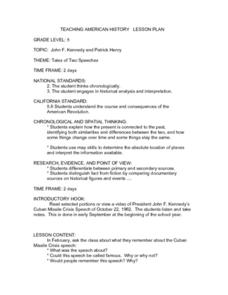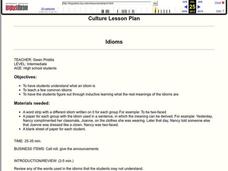Curated OER
Idioms
Young scholars, who are not native English speakers, determine how idioms are used in speaking and writing. In this idiom lesson, students listen to tapes of non-native speakers, and work on vocabulary exercises aimed at increasing their...
Curated OER
The Outsiders
Tenth graders complete a variety of activities related to the first two chapters of the book The Outsiders. They define metaphor, simile, idiom, and hyperbole, and take a vocabulary pre-quiz. In small groups, they write a character...
Curated OER
Descriptions with The Very Hungry Caterpillar
Explore famous artists of the Spanish-speaking world to practice describing things. The kids will identify the color each picture uses, whether figures are large or small, what the people look like, etc. Then, read The Very Hungry...
Curated OER
History Personified
Students explore historical events by writing a research paper using personification.
Curated OER
Sense Poetry
Access your young poets' senses and emotions with this activity, which guides them through the process of writing a "sense poem." After working on a sense poem as a class and modeling the procedure, individuals work on their own poems...
Curated OER
Wall Reading
Students are given practice in scan reading and in revising verb forms. They are given copies of Worksheet 2. Students are told that they should answer all the questions on the Worksheet and that it is a 'race.' They use thier short-term...
ReadWriteThink
Alliteration All Around
Discover alliteration found in picture books by Pamela Duncan Edwards. Then, dive into a read aloud of Alligators All Around by Maurice Sendak. This practice sets the stage for budding poets to create their own acrostic poem,...
National Endowment for the Humanities
Hopi Poetry
The Hopi refer to corn as their children, demonstrating its importance to the Native American group. Class members consider the role of literal and figurative language by examining poetry from this indigenous group. The resource includes...
Curated OER
Sound Devices in Poetry, Fiction and Nonfiction
Students examine the impact of sound devices in poetry. In this poetry lesson, students read the listed poems and identify uses of alliteration, repetition, consonance, rhythm, rhyme, and slang. Students discuss how sound devices enhance...
Curated OER
Valentine Cinquain
Learners review parts of speech by using Inspiration. They brainstorm vocabulary that fit a Valentines theme. Students watch as the teacher demonstrates the parts of a cinquain poem. Learners write their own poem and create a KidPix...
Curated OER
Preposition Man
Students practice using prepositions by writing on the tracing of a human. In this parts of speech lesson, students create a giant poster using the tracing of a classmate's body and fill in the outline using prepositions in places...
Curated OER
Valentine's Day Hearts
Students consider idiomatic expressions that use the word, "heart". They illustrate an assigned idiom and present it to the class. They use the illustrations to guess which idiom is being represented.
Curated OER
Seventeenth Century Pick-up Lines
Students analyze passages from The Mysteries of Love and Eloquence, or the Arts of Wooing and Complementing, written in the seventeenth century. Students analyze the images, words and figures of speech the author used and compare the...
Curated OER
Journeying to Create
Show a video clip that descripes how taking a journey can change a person's outlook on life. Learners write a paragraph about a place that uses imagery and tone to create a specfic effect. They evaluate their journal entries as well.
Curated OER
A Creative Presentation
Bring writing to life with this lesson in which elementary and middle schoolers create a display of the imagery they identify in a series of Gary Paulsen books. They read the suggested materials, identify imagery and descriptive...
English Enhanced Scope and Sequence
Media Literacy Applied
After investigating various forms of print, oral, and electronic media as sources of information, class members research a historical figure and produce a résumé for this person. While templates are provided for an initial sorting...
Curated OER
Two Sides, Same Coin: How Political Beliefs Influence Language Use
Learners read several magazine articles on the same topic written from different political perspectives, paying particular attention to the diction, syntax, and arguments presented in support the point of view expressed. They then select...
Curated OER
Tale of Two Speeches
Students view and read portions of John F. Kennedy's Cuban Missile Crisis speech from October 22, 1962. Later in the year, students recall what they remember about the speech and use a Venn Diagram to compare it to Patrick Henry's...
National First Ladies' Library
"Rolling Out the Red Carpet," and Other Idioms
Students study the idiom as a form of speech. They practice using idioms by developing a Jeopardy game using a provided template.
Curated OER
Negative Imperatives and Idioms
Students identify and use positive and negative imperatives and idioms in written and spoken dialogues, and use irregular verbs in written and spoken sentences. They complete various worksheets, re-write dialogues, and complete an...
Curated OER
Idioms...not the be taken literally!
Students define common English idioms which they find in books and book excerpts. They use an idiom dictionary and constuct a database of five idioms along with meanings and sentences. They beam this information to classmates.
Curated OER
Idioms
Students explore the use of common idioms and deduce the correct meanings of idioms.
Curated OER
Idioms
Students examine the use of idioms in everyday language. They discuss the meanings of various idioms, complete a worksheet, and create a poster to illustrate a selected idiom.
Curated OER
Negative Imperatives and Idioms
Young scholars identify negative imperatives in sentences. They practice using positive and negative imperatives in their written and spoken dialogue. They complete a worksheet to end the lesson.























